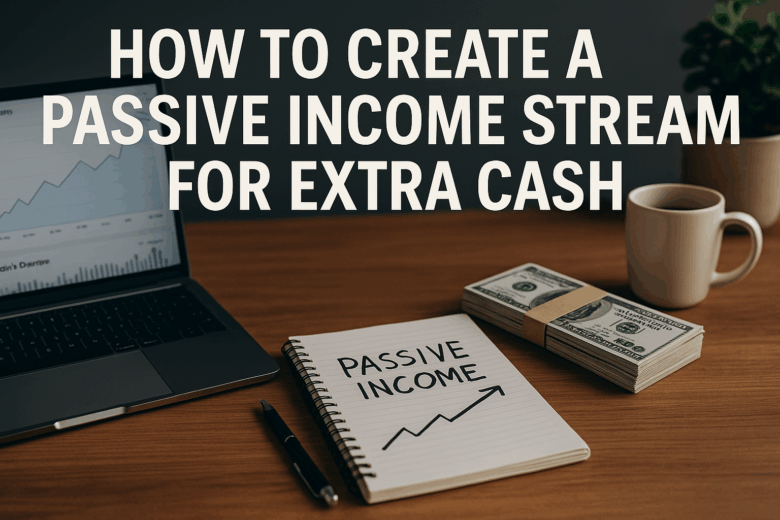In today’s fast-paced world, more and more people are looking for ways to earn extra money without trading more of their time. That’s where passive income comes in. Unlike active income—where you work for every dollar you earn—passive income allows you to earn money while you sleep, travel, or spend time with your family.
Creating a passive income stream doesn’t mean getting rich overnight. It takes planning, effort, and sometimes a financial investment upfront. But once set up, it can be a powerful way to boost your finances, build wealth, and gain more financial freedom.
In this guide, we’ll walk you through what passive income is, why it matters, and step-by-step strategies to help you create your own passive income stream.
What Is Passive Income?
Passive income is money earned with minimal effort or time after the initial setup. It’s not about doing nothing—it’s about working smart early on so you can reap the rewards later.
Some common examples include:
- Rental income from real estate
- Royalties from books or music
- Profits from an online course or digital product
- Earnings from a blog or YouTube channel
- Dividends from stocks
- Interest from savings or investments
- Affiliate marketing commissions
With passive income, the goal is to create a system that keeps earning you money over time, without constant involvement.
Why You Should Build a Passive Income Stream
Here are a few compelling reasons why passive income is worth pursuing:
- Financial stability: Adds extra cash flow to your monthly budget
- Freedom: Reduces dependency on a single job or paycheck
- Flexibility: Lets you earn even when you’re not actively working
- Wealth building: Helps you save, invest, and plan for the future
- Opportunity to retire early: More income now means more choices later
Whether you want to pay off debt, save for a trip, or eventually leave your 9-to-5, passive income gives you more control over your finances.
Step 1: Choose the Right Passive Income Idea for You
Not all passive income ideas are created equal. Some require more time, others more money. The key is to choose something that aligns with your skills, resources, and goals.
Popular Passive Income Ideas:
1. Create an Online Course or Digital Product
If you have expertise in a specific area (marketing, photography, cooking, etc.), you can turn that knowledge into a course. Platforms like Teachable or Gumroad make it easy to sell digital products.
2. Start a Blog or Niche Website
Blogs can generate income through ads, affiliate links, and digital product sales. It takes time to grow traffic, but once it does, it can provide consistent revenue.
3. Invest in Dividend Stocks
Stocks that pay dividends give you a regular payout, just for owning shares. It’s one of the most popular ways to earn passive income with less effort.
4. Buy a Rental Property
Real estate is a classic passive income source. If managed well, rental properties can provide reliable monthly cash flow and long-term appreciation.
5. License Your Creative Work
Are you an artist, musician, or writer? Sell your photos, music, or eBooks online. Every download or sale earns you money, even after the initial effort.
6. Peer-to-Peer Lending or High-Yield Savings
You can invest in lending platforms or high-interest savings accounts that pay returns over time. These require less work but offer lower returns compared to other methods.
Step 2: Make a Plan and Set Realistic Goals
Passive income doesn’t just happen. It needs a clear plan, consistent action, and measurable goals.
Here’s how to get started:
- Define your goal: Are you trying to make $100 extra per month or build a full-time income stream?
- Evaluate your resources: How much time and money can you invest upfront?
- Choose one idea to start: Focus on one source at a time to avoid burnout.
- Set a timeline: Create a 3-month or 6-month plan to launch and optimize your income stream.
- Track your progress: Monitor your results and adjust your strategy if needed.
Step 3: Invest Time or Money Upfront
Every passive income stream requires an initial investment—either your time, money, or both.
For example:
- If you’re starting a blog, you’ll need to write content, build a website, and promote it.
- If you’re investing in real estate, you’ll need capital for the down payment and time to manage the property.
- If you’re creating a course, it takes time to plan, film, edit, and publish your material.
The more effort you put into creating high-quality, value-driven products or systems, the more likely they are to generate long-term income.
Step 4: Automate and Optimize
Once your passive income source is live, it’s time to automate the process as much as possible.
Ways to automate:
- Set up recurring payments from affiliate programs or subscription models.
- Use email automation tools to nurture leads and drive sales.
- Hire a property manager for real estate rentals to handle day-to-day issues.
- Use scheduling software to post content to social media or blogs.
After automation, focus on optimization:
- Improve your blog’s SEO to attract more traffic
- Run ads or promotions to increase course sales
- Reinvest earnings to grow your portfolio
Optimization ensures your passive income stream stays profitable and continues to grow over time.
Step 5: Diversify Your Passive Income Streams
Once you’ve successfully launched one income stream, consider expanding to others. Relying on a single source is risky. Diversifying your income gives you more stability.
Example diversification strategy:
- Blog monetized with ads and affiliate links
- eBook sold through Amazon Kindle
- Small dividend portfolio
- Online course on a skill you’ve mastered
Having multiple streams not only boosts your total earnings but also protects you in case one stream slows down or stops working.
Step 6: Stay Consistent and Patient
Building passive income is not a get-rich-quick scheme. It takes time to see results. You might work for weeks—or even months—before seeing your first dollar. But once your system is in place, the payoff can be significant.
Here’s what to remember:
- Stay consistent: Work on your project regularly, even if just a few hours per week
- Stay patient: Most successful passive income streams take 6–12 months to start showing real returns
- Celebrate milestones: Whether it’s your first sale or your first $100, acknowledge your progress
Common Mistakes to Avoid
To increase your chances of success, steer clear of these common pitfalls:
- Chasing trends without a plan: Focus on value, not hype
- Giving up too early: Results take time—stick with it
- Ignoring marketing: Even the best product won’t sell without visibility
- Neglecting your audience: Know who you’re serving and what they need
- Failing to reinvest: Reinvest some earnings to improve or expand your income streams
Creating a passive income stream is one of the smartest ways to take control of your financial life. It empowers you to earn more without constantly working more, giving you time and flexibility to enjoy what matters most.
Whether you’re starting small with a blog or making a larger investment into real estate, the important thing is to start. Don’t wait for the perfect moment. Start with what you have, learn as you go, and stay committed.
With consistency, patience, and the right strategy, you can build reliable streams of passive income that will pay you long into the future.




